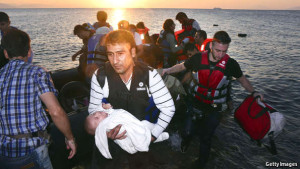FINLAND, with its baffling language and culture of reserve, is not an easy place for outsiders to penetrate. For Nura Farah, the breakthrough came via the dissected brains of dead cows. Ms Farah, who arrived with her mother in 1993 as a teenager seeking asylum from Somalia’s civil war, spent eight years dreaming of a better life in London while she was taunted at school and bore racist abuse on the streets. But in 2001, working as a lab technician in Helsinki, she found herself charged with testing cow tissue for bovine spongiform encephalopathy, or mad-cow disease. The work was fulfilling, her colleagues encouraging, and she moved on to bigger challenges. She took on Finnish citizenship, gave birth to a son and last year became the first Somali Finn to publish a novel.

Finland is a long way from the migrant trouble that has erupted across Europe this summer. But as a country with little history of immigration that has had to integrate an unfamiliar minority, its experience resonates. Most EU countries will soon start receiving asylum-seekers from Italy and Greece, the main entry-points for illegal migrants. Many residents, particularly in Europe’s eastern half, resent this intrusion. Yet Europe’s migrant crisis has seemingly outgrown national responses.
Not since the second world war has the continent faced refugee flows of such complexity and scale. Smugglers are exploiting the political vacuum in Libya to transport Africans across the Mediterranean to Italy. Refugees from Syria’s civil war clamber into rubber dinghies at Turkish ports to reach Greek islands. Then they traverse the continent by the thousand, causing havoc at borders and leaving officials to choose between haplessness and brutality. Migrants who have endured the savagery of the Islamic State or the caprice of Eritrea’s police state find themselves tear-gassed by Macedonian police or evading the clutches of French security guards.
The raw numbers
Around 270,000 illegal migrants have reached Europe’s shores so far this year, more than in the whole of 2014, itself a record year. These numbers should be manageable in a continent of 500m; but asylum-seekers’ preferences for certain parts of Europe over others create pinch points at borders and tensions between governments. Some have resorted to security measures to keep migrants out; others speed their passage to the next state. What such responses share is a wish to pass the problem on. The current crisis is testing, and fracturing, that approach.
European Union officials in Brussels are searching for a common migration policy. Their first success, after 800 would-be migrants drowned off the Libyan coast in April, was to persuade Europe’s leaders to triple Operation Triton, a border-surveillance mission that operates south of Italy. Tens of thousands of migrants have been picked up since then; 4,400 on one day, August 22nd. After a shocking beginning to the year the death rate has plummeted.
Source: The Economist



